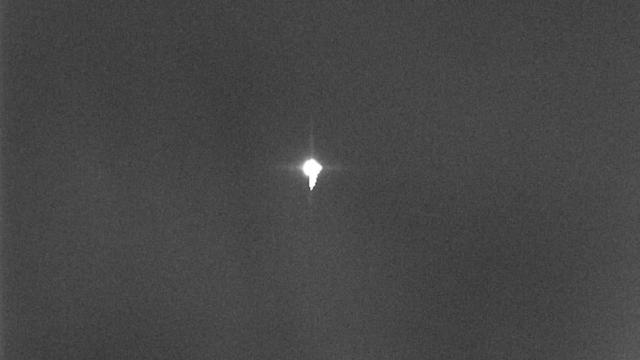A glistening image of China’s wayward Long March 5B rocket, which is expected to make an uncontrolled reentry into Earth’s atmosphere this weekend, has been captured by astronomers with the Virtual Telescope Project.
The single-second exposure was captured on May 6.
“At the imaging time, the rocket stage was at about 700 km from our telescope, while the Sun was just a few degrees below the horizon, so the sky was incredibly bright: these conditions made the imaging quite extreme, but our robotic telescope succeeded in capturing this huge debris,” Gianluca Masi, an astronomer with the Virtual Telescope Project, explained in a recent post. “This is another bright success, showing the amazing capabilities of our robotic facility in tracking these objects.”

To which he added: “As you can see, on the bottom of the bright image of the rocket there is the typical CCD blooming effect, due to the extreme brightness of the object.” By “CCD,” Masi is referring to charge-coupled devices — integrated circuits used in digital imaging. More about the CCD blooming effect here.
Masi’s group, in cooperation with the Bellatrix Astronomical Observatory in Italy, uses remotely controlled telescopes to observe space, spotting things like comets, asteroids, and the odd piece of space junk coming back to taunt us.
This time, the robotic system managed to capture China’s 30-metre tall Long March 5B heavy-lift launch vehicle, which launched on April 28. This core stage is currently out of control and expected to re-enter Earth’s orbit on Saturday, May 8 at 10:34 p.m. EDT (Sunday, May 9 at 12:34 p.m. AEST), give or take about 21 hours, according to Masi.
The exact time of re-entry and where the rocket might crash are unknown because, like I just said, it’s literally out of control. The core stage is currently orbiting the planet once every 90 minutes, at speeds reaching more than 6 km per second, making precise predictions very difficult. In an email, Jonathan McDowell, an astrophysicist at the Harvard-Smithsonian Centre for Astrophysics, said “a one-hour error in the reentry time is an 28,968 km error in the location.” Debris from the core stage is likely to fall into the ocean or onto uninhabited areas on land, but a risk to human life and property is not out of the question.
That the rocket is out of control is obviously problematic. Normally, core stages don’t end up in orbit — after boosting their cargo to space, they fall down to a predetermined location on Earth’s surface. In this case, the Long March 5b reached orbit and soon will reenter the atmosphere at a time and place not controlled by China’s space agency. This is now the second incident of its kind involving a Long March 5b (debris from a previous core stage caused damage to villages in Cote d’Ivoire), so it’s possible the system is designed this way. Hard to know, given the secretive nature of China’s space program.
The launch on April 28 was the first of 11 planned, in which Long March 5b rockets will deliver components required for the construction of Tianhe-1 — China’s first independently built space station. Should the next 10 launches go just like this, China will have some answering to do.
